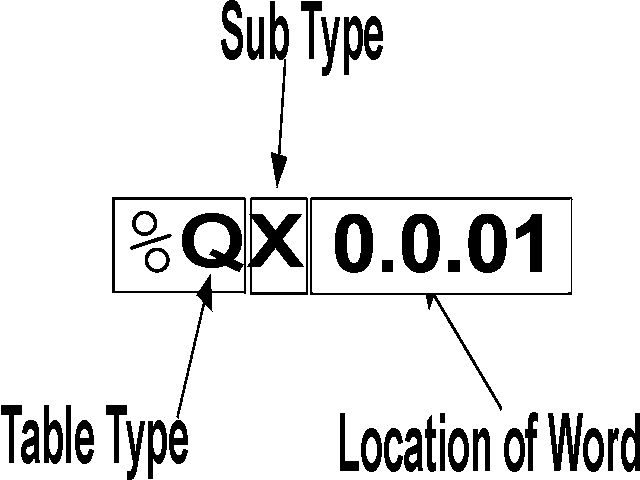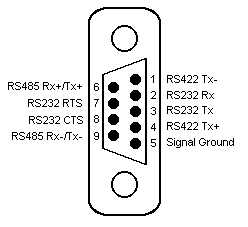
IMO G4, G6, G7, K7
The following information applies to all G Series PLCs except the K7. The K7 talks through the ‘G Series’ protocol, but is configured as a K Series
Details on the Device Address can be found in the Device Properties Information Topic.
External Address Format
The External Address is an ascii string which exactly references an item of data within the PLC. It can be entered at configure time as a text string, and will be validated by the system before use. For this protocol the external address has the following format:
N - Dec number 0 - 9
|
Type |
Sub Type |
Location |
|
%M |
X = Bit B = Byte W = Word D = Double Word |
NNNNN |
|
%Q |
X = Bit B = Byte W = Word D = Double Word |
N.N.NN |
|
%I |
X = Bit B = Byte W = Word D = Double Word |
N.N.NN |
Offset Format
The software also allows an item of data within the PLC to be referenced by means of a table selection and an offset. The following tables show the offset and table formats for the different PLC types:
PLC Tables G4
|
Table |
External Address Type |
Type |
Offset Format |
Offset Range |
Privilege R = Read W = Write |
Description |
|
%MX |
%MX |
Bit |
NNNNN |
00000-49151 |
RW |
Direct variable area as bits |
|
%MB |
%MB |
Byte |
NNNNN |
00000-06143 |
RW |
Direct variable area as bytes |
|
%MW |
%MW |
Word |
NNNNN |
00000-03071 |
RW |
Direct variable area as words |
|
%MD |
%MD |
dWord |
NNNNN |
00000-01535 |
RW |
Direct variable area as dWords |
|
%QX |
%QX |
Bit |
N.N.NN |
0.0.00-3.7.63 |
RW |
Output image as bits |
|
%QB |
%QB |
Byte |
N.N.NN |
0.0.00-3.7.07 |
RW |
Output image as bytes |
|
%QW |
%QW |
Word |
N.N.NN |
0.0.00-3.7.03 |
RW |
Output image as words |
|
%QD |
%QD |
dWord |
N.N.NN |
0.0.00-3.7.01 |
RW |
Output image as dWords |
|
%IX |
%IX |
Bit |
N.N.NN |
0.0.00-3.7.63 |
RW |
Input image as bits |
|
%IB |
%IB |
Byte |
N.N.NN |
0.0.00-3.7.07 |
RW |
Input image as bytes |
|
%IW |
%IW |
Word |
N.N.NN |
0.0.00-3.7.03 |
RW |
Input image as words |
|
%ID |
%ID |
dWord |
N.N.NN |
0.0.00-3.7.01 |
RW |
Input image as dWords |
PLC Tables G6
|
Table |
External Address Type |
Type |
Offset Format |
Offset Range |
Privilege R = Read W = Write |
Description |
|
%MX |
%MX |
Bit |
NNNNN |
00000-65535 |
RW |
Direct variable area as bits |
|
%MB |
%MB |
Byte |
NNNNN |
00000-08191 |
RW |
Direct variable area as bytes |
|
%MW |
%MW |
Word |
NNNNN |
00000-04095 |
RW |
Direct variable area as words |
|
%MD |
%MD |
dWord |
NNNNN |
00000-02047 |
RW |
Direct variable area as dwords |
|
%QX |
%QX |
Bit |
N.N.NN |
0.0.00-1.7.63 |
RW |
Output image as bits |
|
%QB |
%QB |
Byte |
N.N.NN |
0.0.00-1.7.07 |
RW |
Output image as bytes |
|
%QW |
%QW |
Word |
N.N.NN |
0.0.00-1.7.03 |
RW |
Output image as words |
|
%QD |
%QD |
dWord |
N.N.NN |
0.0.00-1.7.01 |
RW |
Output image as dwords |
|
%IX |
%IX |
Bit |
N.N.NN |
0.0.00-1.7.63 |
RW |
Input image as bits |
|
%IB |
%IB |
Byte |
N.N.NN |
0.0.00-1.7.07 |
RW |
Input image as bytes |
|
%IW |
%IW |
Word |
N.N.NN |
0.0.00-1.7.03 |
RW |
Input image as words |
|
%ID |
%ID |
dWord |
N.N.NN |
0.0.00-1.7.01 |
RW |
Input image as dwords |
PLC Tables G7
|
Table |
External Address Type |
Type |
Offset Format |
Offset Range |
Privilege R = Read W = Write |
Description |
|
%MX |
%MX |
Bit |
NNNNN |
00000-65535 |
RW |
Direct variable area as bits |
|
%MB |
%MB |
Byte |
NNNNN |
00000-08191 |
RW |
Direct variable area as bytes |
|
%MW |
%MW |
Word |
NNNNN |
00000-04095 |
RW |
Direct variable area as words |
|
%MD |
%MD |
dWord |
NNNNN |
00000-02047 |
RW |
Direct variable area as dwords |
|
%QX |
%QX |
Bit |
N.N.NN |
0.0.00-0.7.63 |
RW |
Output image as bits |
|
%QB |
%QB |
Byte |
N.N.NN |
0.0.00-0.7.07 |
RW |
Output image as bytes |
|
%QW |
%QW |
Word |
N.N.NN |
0.0.00-0.7.03 |
RW |
Output image as words |
|
%QD |
%QD |
dWord |
N.N.NN |
0.0.00-0.7.01 |
RW |
Output image as dwords |
|
%IX |
%IX |
Bit |
N.N.NN |
0.0.00-0.7.63 |
RW |
Input image as bits |
|
%IB |
%IB |
Byte |
N.N.NN |
0.0.00-0.7.07 |
RW |
Input image as bytes |
|
%IW |
%IW |
Word |
N.N.NN |
0.0.00-0.7.03 |
RW |
Input image as words |
|
%ID |
%ID |
dWord |
N.N.NN |
0.0.00-0.7.01 |
RW |
Input image as dWords |
Property Pages
No property pages exist for this protocol
Protocol Compatibility
Each of the ‘M’ tables references the direct variable area, presenting the same data as different PLC types. In each case the offset references a single unit of the given table base type. The ‘Q’ group of tables (outputs) and the ‘I’ group of tables (inputs) also present the same data as different PLC types, AND are referenced in terms of RACK, SLOT AND ITEM NUMBER.
A bit type table such as ‘%MX’ will only support the configuration of bit type points. No larger point types can be configured as only one bit can be read or written at a time. Since the same data is presented in other tables this does not matter. If a 16 bit value is required, a point could always be configured on the '%MW' table instead of '%MX', as this references the same table.
The byte, word and dWord type tables all support the configuration of smaller or bigger point types. All larger point types will read the required number of data units to fill the point. Smaller type points will scale down the data to fit it into the point. Bit type points allow the selection of a bit offset to reference the required bit from the data unit. In the case of bit selection points, drive outs will perform a 'bitset' operation through the protocol without having to perform a read/modify/write operation on the whole word. The option of using the ‘X’ type tables is always available to look at bit data rather than ‘bit picking’ from the ‘B’, ‘W’ or ‘D’ type tables.
Port Settings
Port settings are configurable for all of the PLC’s within the PLC programming software. The following shows typical port setups
RS485 4 wire/RS485 2 wire
|
|
Baud Rate |
9600 |
|
|
Data Bits |
8 |
|
|
Stop Bits |
1.0 |
|
|
Parity |
None |
RS232 G Series
|
|
Baud Rate |
19200 |
|
|
|
Data Bits |
8 |
|
|
|
Stop Bits |
1.0 |
|
|
|
Parity |
None |
|
Wiring Information
Connection of the PLC to a panel will be via either COM1 or COM2, using RS232, RS485 4 wire or RS485 2 wire communications. The panel pin out diagram is shown below:

Connection of the PLC to a PC running OPC Server will be via any available COM port, which may be either 25 pin or 9 pin depending on what is available. The PC will only support RS232 mode, an intelligent RS485-to-RS232 converter will be required to connect using RS485 2 wire or 4 wire communications. The COM port pin out is shown below:
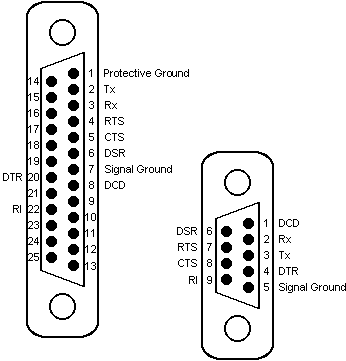
The IMO G PLC has two methods of connection, either through the RS232 port on the CPU module, or by connection to a comms module using RS232, RS485 2 wire or 4 wire communications. The RS232 port on the CPU module has the following pin out:
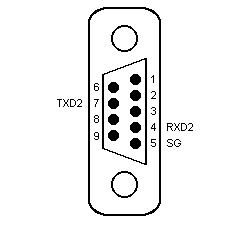
An RS232 comms module has a standard pin out as follows:
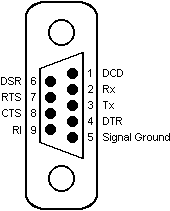
An RS485 comms module has screw terminal connections for RS485 communications.
The following shows the correct wiring for connection to an IMO G series PLC through the CPU module:

The following shows the correct wiring for connection to an IMO G series PLC through a comms module:



Examples
Addressing Table M subtable X
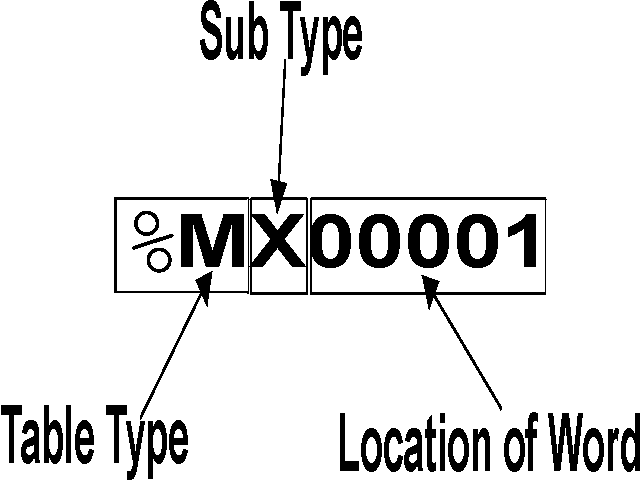
Addressing table Q subtable X
